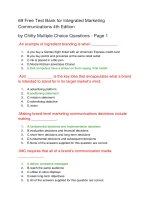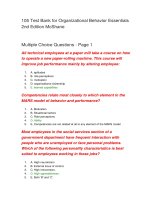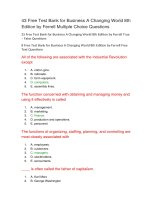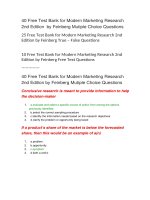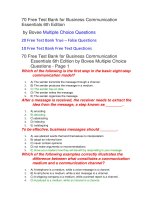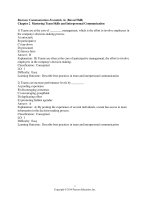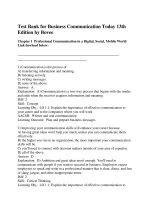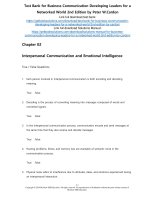100 free test bank for business communication essentials 6th edition
Bạn đang xem bản rút gọn của tài liệu. Xem và tải ngay bản đầy đủ của tài liệu tại đây (129.58 KB, 22 trang )
70 Free Test Bank for Business Communication
Essentials 6th Edition
by Bovee Multiple Choice Questions
20 Free Test Bank True – False Questions
10 Free Test Bank Free Text Questions
70 Free Test Bank for Business Communication
Essentials 6th Edition by Bovee Multiple Choice
Questions - Page 1
Which of the following is the first step in the basic eight-step
communication model?
1.
2.
3.
4.
5.
A) The sender transmits the message through a channel.
B) The sender produces the message in a medium.
C) The sender has an idea.
D) The sender writes the message.
E) The sender organizes the message.
After a message is received, the receiver needs to extract the
idea from the message, a step known as ________.
1.
2.
3.
4.
5.
A) encoding
B) decoding
C) abstracting
D) indexing
E) cataloguing
To be effective, business messages should ________.
1.
2.
3.
4.
5.
A) use abstract words that lend themselves to interpretation
B) adopt an informal tone
C) never contain opinions
D) not make arguments or recommendations
E) show your readers how they will benefit by responding to your message
Which of the following examples correctly illustrates the
difference between what constitutes a communication
medium and a communication channel?
1.
2.
3.
4.
A) A telephone is a medium, while a voice message is a channel.
B) A cell phone is a medium, while a text message is a channel.
C) A shipping company is a medium, while a printed report is a channel.
D) A podcast is a medium, while an intranet is a channel.
5.
E) The Internet is a medium, while a Twitter tweet is a channel.
Which of the following is a tendency of Business
Communication 2.0?
1.
2.
3.
4.
5.
A) permission
B) hierarchical
C) one to many
D) control
E) few channels
Which of the following is the last step in the basic eight-step
communication model?
1.
2.
3.
4.
5.
A) The sender transmits the message through a channel.
B) The audience receives the message.
C) The receiver decodes the message.
D) The receiver responds to the message
E) The receiver provides feedback.
Effective business messages ________.
1.
2.
3.
4.
5.
A) convey abstract ideas
B) provide practical information
C) are usually voluminous
D) do not attempt to influence the reader
E) are usually informal
Which of the following is true about communicating in
today's business environment?
1.
2.
3.
4.
5.
A) Following accepted standards of grammar, spelling and other aspects of highquality business writing are no longer relevant in today's technology-driven
business environment.
B) One should always communicate ethically, even when the choices are not
crystal clear.
C) Constructing compelling narratives—telling stories—is obsolete in today's fastpaced business environment.
D) Adapting your messages and communication styles to specific audiences is
unethical and, often, illegal.
E) It is now an accepted fact that business communication skills are largely innate
and cannot be learnt.
Which of the following is a tendency of Business
Communication 2.0?
1.
2.
3.
4.
5.
A) resistive
B) information hoarding
C) planned
D) unidirectional
E) high message frequency
Business Communication 1.0 tends to be ________.
1.
2.
3.
4.
5.
A) reactive
B) conversational
C) amorphous
D) isolated
E) multidirectional
Which of the following is true about the importance of
effective communication to your career and to the
companies where you will work?
1.
2.
3.
4.
5.
A) Communication is important for most jobs, except technical jobs such as
engineering or finance.
B) The higher you rise in your organization, the more time you spend using the
technical skills of your profession, and the less time you spend communicating.
C) Good communicators are generally more difficult to find than good accountants,
good engineers, or good attorneys.
D) Good communication has not been linked to financial advantages for
companies.
E) Communication is important for most jobs, unless you are an entrepreneur.
Business Communication 2.0 tends to be ________.
1.
2.
3.
4.
5.
A) structured
B) hierarchical
C) unidirectional
D) reactive
E) intrusive
Effective communication strengthens the connections
between a company and all of its ________.
1.
2.
3.
4.
5.
A) factions
B) cliques
C) stakeholders
D) captive audience
E) captive market
The traditional nature of much business communication was
primarily defined by a publishing or broadcasting
mindset. Which of the following scenarios best reflects
this mindset?
1.
2.
A) A company airs advertisements during the Super Bowl to raise its visibility.
B) A company publishes a blog to keep customers informed of the company's
activities.
3. C) A company CEO uses Twitter to interact directly with individual employees.
4. D) A company opens a Facebook account to connect with a younger audience.
5. E) A company holds a townhall-style meeting to respond to employee concerns.
Business Communication 2.0 tends to be ________.
1.
2.
3.
4.
5.
A) amorphous
B) hierarchical
C) unidirectional
D) structured
E) intrusive
Which of the following is a tendency of Business
Communication 2.0?
1.
2.
3.
4.
5.
A) lecture
B) one to many
C) influence
D) control
E) static
A ________ is a form of legal protection for the expression of
creative ideas.
1.
2.
3.
4.
5.
A) patent
B) trademark
C) service mark
D) copyright
E) ghost mark
Which of the following is a tendency of Business
Communication 1.0?
1.
2.
3.
4.
5.
A) reactive
B) information hoarding
C) permission
D) information sharing
E) high message frequency
To be effective, business messages should ________.
1.
2.
3.
4.
5.
A) generate a specific response from a specific audience
B) adopt an informal tone
C) use abstract words that lend themselves to interpretation
D) not make arguments or recommendations
E) never contain opinions
The ________ is interactive, conversational, and usually
open to all who wish to participate; audience members
are not passive recipients of messages but active
participants in a conversation.
1.
2.
A) publishing mindset
B) basic eight-step communication model
3.
4.
5.
C) social communication model
D) broadcasting mindset
E) Business Communication 1.0
Business Communication 2.0 tends to be ________.
1.
2.
3.
4.
5.
A) resistive
B) isolated
C) dynamic
D) structured
E) unidirectional
Which of the following is a tendency of Business
Communication 2.0?
1.
2.
3.
4.
5.
A) unidirectional
B) egalitarian
C) resistive
D) structured
E) information hoarding
In the basic communication model, when someone puts an
idea into a message, he or she is ________.
1.
2.
3.
4.
5.
A) encoding it
B) decoding it
C) broadcasting it
D) indexing it
E) cataloguing it
Which of the following is a disadvantage of the social
communication model?
1.
2.
3.
4.
5.
A) It is hierarchical.
B) The number of channels is limited in this model.
C) The frequency of messages on this model is relatively low.
D) It blurs the line between personal and professional lives.
E) It is unidirectional.
Which of the following is a disadvantage of the social
communication model?
1.
2.
3.
4.
5.
A) It can cause distractions and hit productivity.
B) It is static.
C) It is hierarchical.
D) The frequency of messages is relatively low.
E) It is unidirectional.
Which of the following is a disadvantage of the social
communication model?
1.
2.
3.
4.
5.
A) It is hierarchical.
B) It is static.
C) It can lead to information overload.
D) The frequency of messages is relatively low.
E) It is unidirectional.
Which of the following is true about the importance of
effective communication to your career and to the
companies where you will work?
1.
2.
3.
4.
5.
A) Communication is important for most jobs, except technical jobs such as
engineering or finance.
B) The higher you rise in your organization, the more time you spend using the
technical skills of your profession, and the less time you spend communicating.
C) Good communicators are generally much easier to find than good accountants,
good engineers, or good attorneys.
D) Companies that communicate well significantly outperform those that
communicate poorly.
E) Communication is important for most jobs, unless you are an entrepreneur.
Which of the following is a disadvantage of the social
communication model?
1.
2.
3.
4.
5.
A) It is hierarchical.
B) It is static.
C) It is unidirectional.
D) The frequency of messages is relatively low.
E) It presents information security risks.
To be effective, business messages should ________.
1.
2.
3.
4.
5.
A) use abstract words that lend themselves to interpretation
B) never contain opinions
C) present expansive and repetitive information
D) not make arguments or recommendations
E) give facts rather than vague impressions
Which of the following constitutes ethical information?
1.
2.
A) a restaurant using photos of dishes that it does not serve on its website
B) a vendor including only essential information in promotional material mailed out
to customers
3. C) a company paying customers to recommend its products to their friends
4. D) a manufacturer of cell phones asking its sales team to post favorable product
reviews on social media
5. E) a hospitality chain deleting all negative comments from the company's blog
To be effective, business messages should ________.
1.
2.
3.
4.
5.
A) use abstract words that lend themselves to interpretation
B) adopt an informal tone
C) present information in a concise, efficient manner
D) not make arguments or recommendations
E) never contain opinions
The most important element of audience-centered
communication is ________.
1.
2.
3.
4.
5.
A) etiquette
B) dialog
C) permission
D) discussion
E) high message frequency
Which of the following is true about the importance of
effective communication to your career and to the
companies where you will work?
1.
2.
3.
4.
5.
A) Communication is important for most jobs, except technical jobs such as
engineering or finance.
B) The higher you rise in your organization, the less time you spend using the
technical skills of your profession, and the more time you spend communicating.
C) Good communicators are generally much easier to find than good accountants,
good engineers, or good attorneys.
D) Good communication has not been linked to financial advantages for
companies.
E) Communication is important for most jobs, unless you are an entrepreneur.
Which of the following is true about communicating in
today's business environment?
1.
2.
3.
4.
5.
A) It is important to recognize that it is not possible to communicate ethically when
the choices are not crystal clear.
B) Following accepted standards of grammar, spelling and other aspects of highquality business writing are no longer relevant in today's technology-driven
business environment.
C) Constructing compelling narratives—telling stories—is obsolete in today's fastpaced business environment.
D) Adapting your messages and communication styles to specific audiences is
crucial to business communication today.
E) It is now an accepted fact that business communication skills are largely innate
and cannot be learnt.
70 Free Test Bank for Business Communication
Essentials 6th Edition by Bovee Multiple Choice
Questions - Page 2
Which of the following is an effective tip for speaking with
multilingual audiences?
1.
2.
A) Ask questions like "Is this too difficult for you?" to ensure understanding.
B) Look for nods and smiles to know if your audience is understanding your
message.
3. C) Make multiple points at a time.
4. D) Don't repeat your points.
5. E) Learn important phrases in your audiences language.
________ is the tendency to judge all other groups according
to the standards, behaviors, and customs of one's own
group.
1.
2.
3.
4.
5.
A) Cultural context
B) Stereotyping
C) Ethnocentrism
D) Ethical lapse
E) Ethical dilemma
In high-context cultures, ________.
1.
2.
3.
4.
5.
A) people rely less on circumstances surrounding the message to convey meaning
B) the primary role of communication is to build relationships
C) people rely less on the explicit content of messages to convey meaning
D) the conveyed meaning is encoded into the message itself
E) people rely less on cues to convey meaning
Advanced systems for videoconferencing can feature
telepresence, a technology that allows you to
________.
1.
2.
3.
4.
5.
A) view video images that are life-sized and extremely realistic
B) convert email and IM into voice messages
C) automatically forward incoming calls
D) contribute to and edit the same document from remote locations
E) hold meetings in virtual worlds like Second Life
When using communication technology, it is important to
________.
1.
2.
3.
4.
A) use blog feeds and Twitter follows to the maximum extent possible
B) reconnect with people on the phone or in person frequently
C) use technology to completely do away with face-to-face communication
D) pay equal attention to all the information—immediately useful or not—that you
receive
5. E) expand your social networks online to the maximum extent possible
In order to communicate effectively using technology, you
should ________.
1.
2.
3.
4.
5.
A) guard against information overload
B) always activate visual alerts for incoming messages
C) use technology to completely do away with face-to-face communication
D) use blog feeds and Twitter follows to the maximum extent possible
E) expand your social networks online to the maximum extent possible
Which of the following is true about making ethical
communication choices?
1.
2.
3.
4.
5.
A) An ethical dilemma involves making a clearly unethical, and often illegal,
choice.
B) An ethical lapse involves choosing among alternatives that are not clearly right
or wrong.
C) When making communications decisions, you must always consider if a
decision that seems ethical now may seem unethical in the future.
D) Deliberately omitting essential information is an ethical way of influencing the
audience.
E) In business scenarios, you cannot afford the luxury of considering the impact of
your messages on the audience.
In order to use communication technology effectively, you
should NOT ________.
1.
2.
3.
4.
5.
A) use the powerful filtering and tagging capabilities of your system
B) let technology overwhelm the communication process
C) connect with people face-to-face frequently
D) limit your presence on online social networks
E) try to control the number and types of messages you receive
Which of the following is a guideline for improving
intercultural communication?
1.
2.
3.
4.
5.
A) Consider aspects like personal appearance when trying to judge a person.
B) Avoid using sources like travel guidebooks to learn about a culture.
C) Recognize your own cultural biases.
D) Always assume that others will think, believe, and behave as you do.
E) Do not tolerate ambiguity of any kind.
Which of the following is true about making ethical
communication choices?
1.
A) An ethical dilemma involves making a clearly unethical, and often illegal,
choice.
2. B) An ethical lapse involves choosing among alternatives that are not clearly right
or wrong.
3. C) In business scenarios, you cannot afford the luxury of considering the impact of
your messages on the audience.
4.
D) Deliberately omitting essential information is an ethical way of influencing the
audience.
5. E) Decisions should achieve the greatest possible good while doing the least
possible harm.
In low-context cultures, ________.
1.
2.
3.
A) the primary role of communication is to exchange information
B) people rely less on the explicit content of the message
C) people rely more on the circumstances surrounding the message to convey
meaning
4. D) people rely more on situational cues to convey meaning
5. E) the rules of everyday life are rarely stated explicitly
________ marketing involves attempting to promote
products and services to customers who don't know
they are being marketed to.
1.
2.
3.
4.
5.
A) Stealth
B) Ambush
C) Affiliate
D) Viral
E) Loyalty
Which of the following is a guideline for improving
intercultural communication?
1.
2.
3.
4.
5.
A) Consider aspects like personal appearance when trying to judge a person.
B) Be flexible and be prepared to change your habits and attitudes.
C) Avoid using sources like travel guidebooks to learn about a culture.
D) Always assume that others will think, believe, and behave as you do.
E) Do not tolerate ambiguity of any kind.
An activist group accuses a leading cell phone and netbook
manufacturer of deceiving customers through its
stealth marketing campaign. The group argues that
stealth marketing is unethical. They claim that the
company hired several actors and rewarded them for
promoting products. The campaign involved visiting
stores on weekends and during the peak season,
using their products on commuter trains, bars, and
coffee shops. Which of the following, if true,
strengthens the argument?
1.
A) Last year, thirty-five percent of Fortune 500 adopted Word of Mouth Marketing
campaigns.
2. B) The company did not give their targets the opportunity to raise instinctive
defenses against persuasive marketing messages.
3.
C) Around seventy-five percent of cell phone consumers state that they heard of
the product from friends.
4. D) The Advertising Standards Authority claims that leading companies are using
stealth marketing to manipulate customer base.
5. E) The company offered 350,000 people a source of income through its stealth
marketing campaign.
In order to boost sales for its tablets, Zip Communications
paid several students to carry the gadgets to college
and talk to their friends and classmates about the
great features of the product. What is the best criticism
of Zip's decision?
1.
2.
3.
4.
5.
A) It selectively misquoted information.
B) It failed to protect customer information.
C) It engaged in stealth marketing.
D) It violated a copyright.
E) It failed to respect others' privacy.
When writing for multilingual audiences, you should
________.
1.
2.
3.
4.
5.
A) use slang and jargon
B) spell numbers out instead of using figures
C) use transitions generously
D) use abbreviations extensively
E) use long paragraphs and sentences
Which among the following is the most low-context culture?
1.
2.
3.
4.
5.
A) Chinese
B) Indian
C) German
D) Japanese
E) Arab
In order to use communication technology effectively, you
should NOT ________.
1.
2.
3.
4.
5.
A) use the powerful filtering and tagging capabilities of your system
B) limit your presence on online social networks
C) connect with people face-to-face frequently
D) routinely activate visual alerts for incoming messages
E) try to control the number and types of messages you receive
When writing for multilingual audiences, you should
________.
1.
2.
A) use slang and jargon
B) spell numbers out instead of using figures
3.
4.
5.
C) use transitions sparingly
D) use abbreviations generously
E) rely on specific terms and concrete examples to explain your points
When writing for multilingual audiences, you should
________.
1.
2.
3.
4.
5.
A) use slang and jargon
B) spell numbers out instead of using figures
C) use transitions sparingly
D) use abbreviations carefully
E) use long paragraphs and sentences
Which of the following decision making scenarios presents
an ethical dilemma?
1.
2.
3.
4.
5.
A) A disgruntled employee of one of your competitors has offered to reveal details
of his company's new strategy if you were to hire him. This competitor has in the
past poached key executives from your company and engaged in industrial
espionage in other ways.
B) You are manager of a large facility in a country where paying bribes to public
officials is a way of life. Your company has a zero-tolerance policy toward bribing,
but the officials are threatening to close down the factory, rendering several
thousand workers jobless, if you don't comply.
C) It has been brought to your notice that the company competing with you for a
major contract is trying to bribe and influence decision-makers in a bid to get the
contract. Some of your executives feel that your company should also do the same
because getting this contract will make a big difference to the company's future.
D) The last inspection at your plant revealed structural problems with some of the
buildings that, if not fixed immediately, could compromise worker safety. However,
your company is low on funds and taking on repair work will push the company into
the red.
E) During a conversation with a friend, you come across information that will
significantly impact the stock prices of a company's share in the near future. As
Funds Manager at a bank, leveraging this information will allow you to improve the
retirement savings of several senior citizens.
Which of the following is true about communication
challenges presented by cultural context?
1.
2.
3.
4.
5.
A) A person from a low-context culture is more likely to view a high-context
person's work culture as being insensitive to group harmony.
B) A person from a high-context culture is more likely to consider personal pledges
more important than contracts.
C) In a low-context culture, people are more likely to consider gestures and tone of
voice when receiving a message.
D) In a high-context culture, the rules of everyday life are stated explicitly.
E) A person from a high-context culture is more likely to adhere strictly to the law.
Assigning a wide range of generalized—and often inaccurate
—attributes to an individual on the basis of
membership in a particular group, without considering
the individual's unique characteristics is referred to as
________.
1.
2.
3.
4.
5.
A) ethical lapse
B) cultural competency
C) profiling
D) cognitive dissonance
E) stereotyping
In order to communicate effectively using technology, you
should ________.
1.
2.
3.
4.
5.
A) become an expert in most technologies
B) try to isolate high-priority messages that need your attention
C) use technology to completely do away with face-to-face communication
D) use blog feeds and Twitter follows to the maximum extent possible
E) expand your social networks online to the maximum extent possible
In order to communicate effectively using technology, you
should ________.
1.
2.
3.
4.
5.
A) subscribe to as many blog feeds and Twitter follows as you can
B) become an expert in most technologies
C) use technology to completely do away with face-to-face communication
D) become familiar with the basic features and functions of the tools you use
E) expand your social networks online to the maximum extent possible
When writing for multilingual audiences, you should
________.
1.
2.
3.
4.
5.
A) use slang and jargon
B) use figures instead of spelling out numbers
C) use transitions sparingly
D) use abbreviations generously
E) use long paragraphs and sentences
Which of the following is an effective tip for speaking with
multilingual audiences?
1.
2.
3.
4.
5.
A) Ask questions like "Is this too difficult for you?" to ensure understanding.
B) Adapt your conversation style to the other person's.
C) Make multiple points at a time.
D) Don't repeat your points.
E) Look for nods and smiles to ensure your audience is understanding your
message.
In high-context cultures, ________.
1.
2.
3.
4.
5.
A) rules and expectations are spelt out through explicit statements
B) the primary role of communication is to exchange information
C) people rely less on cues to convey meaning
D) the conveyed meaning is encoded into the message itself
E) people rely more on circumstances surrounding the message to convey
meaning
Which of the following is a tip for speaking with multilingual
audiences?
1.
2.
3.
4.
A) Ask questions like "Is this too difficult for you?" to ensure understanding.
B) Don't repeat your points.
C) Make multiple points at a time.
D) Do not assume the audience's smiles and nods to be a sign that they
understood your point.
5. E) Avoid checking frequently for comprehension.
One aspect that is common across cultures is that
________.
1.
2.
3.
4.
5.
A) the percentage of management roles held by men and women are roughly
equal
B) age earns respect and increasing power and freedom
C) nonverbal signs like gestures or facial expressions are interpreted the same
way
D) men and women tend to have slightly different communication styles
E) age is often associated with declining powers and a loss of respect and
authority
In low-context cultures, ________.
1.
2.
3.
4.
5.
A) people rely more on the circumstances surrounding the message to convey
meaning
B) the primary role of communication is to build relationships
C) people rely more on the explicit content of the message to convey meaning
D) people rely more on cues to convey meaning
E) the rules of everyday life are rarely stated explicitly
Which of the following is a guideline for improving
intercultural communication?
1.
2.
3.
4.
5.
A) Consider aspects like personal appearance when trying to judge a person.
B) Do not tolerate ambiguity of any kind.
C) Avoid using sources like travel guidebooks to learn about a culture.
D) Always assume that others will think, believe, and behave as you do.
E) Avoid ethnocentricity and stereotyping
Jeremy is a manager at the telecommunication customer
care branch of a leading router manufacturing
company based in the U.S. He argues that hiring native
speakers of English will ensure higher customer
satisfaction and better customer care service. Which
of the following, if true, weakens his argument?
1.
2.
3.
4.
5.
A) Workers are more productive when managers communicate in their native
language.
B) English fluency and accent modification are an integral part of training for
customer care executives.
C) Global firms promote talented executives who can work in a multicultural
diverse environment.
D) In the U.S., minorities are the fastest growing consumer group holding $3
trillion buying power.
E) Non-native speakers of English bring diversity to the workplace.
________—which involves inviting input from groups of
people inside or outside the organization—gives
companies access to a much wider range of ideas,
solutions to problems, and insights into market
trends.
1.
2.
3.
4.
5.
A) Ethnocentrism
B) Crowdsourcing
C) Applicant Tracking systems
D) Speech synthesis
E) Scaffolding
Which among the following is the most high-context
culture?
1.
2.
3.
4.
5.
A) American
B) English
C) German
D) Chinese
E) Irish
In order to generate interest about the company's
publications, the Media Manager of Gordon Books
started a personal blog where she posed as an avid
reader and amateur literary critic and reviewed the
company's books favorably. She also invited readers
to buy the books, discuss them online, and send in
their reviews. Which of the following is the best
criticism of the manager's action?
1.
2.
3.
4.
5.
A) She engaged in plagiarism.
B) She selectively misquoted information.
C) She failed to protect information entrusted to her.
D) She failed to ensure transparency.
E) She failed to respect the privacy of others.
Total Points: 0 correct out of 7
20 Free Test Bank for Business Communication
Essentials 6th Edition by Bovee True - False
Questions
Cultural competency is an appreciation for cultural
differences that affect communication and the ability
to adjust one's communication style to ensure that
efforts to send and receive messages across cultural
boundaries are successful.
1.
2.
True
False
Legal systems and ethical standards are universal.
1.
2.
True
False
The medium of a message refers to the form a message
takes and the channel is the system used to deliver the
message.
1.
2.
True
False
An audience-centered approach to communication means
that professionals focus on giving vague impressions
to meet the needs of the audience.
1.
2.
True
False
Ensuring ethical business communication requires three
elements: ethical individuals, ethical company
leadership, and the appropriate policies and structures
to support ethical decision making.
1.
2.
True
False
Communication becomes less important as you take on
leadership and management roles.
1.
2.
True
False
Effective use of communication technologies require
expertise in the use of tools, information overload to
make better decisions, and self-serving messages to
ensure communication.
1.
2.
True
False
Companies use communication technologies such as social
networking, microblogging, and user-generated
content sites to foster a sense of community among
customer, enthusiasts, and other groups.
1.
2.
True
False
The ability to follow accepted standards of grammar,
spelling, and other aspects of high-quality writing and
speaking is a skill employers expect of you today.
1.
2.
True
False
An ethical lapse involves choosing among alternatives that
aren't clear-cut.
1.
2.
True
False
Companies that communicate well significantly outperform
those that communicate poorly.
1.
2.
True
False
In high-context cultures the rules of everyday life are stated
explicitly.
1.
2.
True
False
Decoding refers to the process of expressing an idea into a
message using words and images.
1.
2.
True
False
An ethical dilemma can involve choosing between two
conflicting alternatives that are both ethical and valid.
1.
2.
True
False
The social communication model is primarily defined by a
broadcasting or publishing mindset.
1.
2.
True
False
Selective misquoting and stealth marketing are considered
ethical.
1.
2.
True
False
Information overload develops the ability to think deeply
about complex situations, reduces employee stress,
and increases productivity.
1.
2.
True
False
Business Communication 2.0 is bidirectional and tends to
have high message frequency.
1.
2.
True
False
The social communication model includes information
overload, information security risks, and the need to
monitor and respond to numerous conversational
threads.
1.
2.
True
False
According to the basic eight-step model of communication,
the communication process starts with the sender
producing a message in a transmittable medium.
1.
2.
True
False
0 Free Test Bank for Business Communication
Essentials 6th Edition by Bovee Free Text
Questions
Explain the concept of information overload. How can you
guard against information overload when using
communication technology?
Answer Given
The overuse or misuse of communication technology can lead to information
overload, in which people receive more information than they can effectively
process. Information overload makes it difficult to discriminate between useful and
useless information, inhibits the ability to think deeply about complex situations,
lowers productivity, and amplifies employee stress both on the job and at home—
even to the point of causing health and relationship problems. To guard against
information overload, as a sender, make sure every message you intend to send is
meaningful and important to your receivers. As a recipient, take steps to control
the number and types of messages you receive. Don't activate visual alerts for
incoming messages unless you absolutely need to know the instant a message
arrives; each alert breaks your concentration and requires time for you to refocus.
Many systems have powerful filtering and tagging capabilities that can
automatically sort incoming messages based on criteria you set. Use this feature
to isolate high-priority messages that deserve your attention. Also, be wary of
subscribing to too many blog feeds, Twitter follows, and other sources of recurring
messages. Take care when expanding your social networks online so that you
don't get buried with inessential posts and updates. Identify the information you
really need and focus on those sources.
What are the advantages and challenges of a diverse
workforce?
Answer Given
A diverse workforce offers a broader spectrum of viewpoints and ideas, helps
companies understand and identify with diverse markets, and enables companies
to benefit from a wider range of employee talents. More diverse teams can tend to
be more innovative over the long term than teams composed of people from the
same culture. For all their benefits, diverse workforces and markets do present
some communication challenges, and understanding the effect of culture on
communication is essential. The subconscious effect of culture can create friction
because it leads people to assume that everybody thinks and feels the way they
do.
Distinguish between ethical dilemmas and ethical lapses,
giving appropriate examples for both.
Answer Given
An ethical dilemma involves choosing among alternatives that aren't clear-cut.
Perhaps two conflicting alternatives are both ethical and valid, or perhaps the
alternatives lie somewhere in the gray area between clearly right and clearly
wrong. Unlike a dilemma, an ethical lapse is a clearly unethical (and frequently
illegal) choice.
Explain the concepts of transparency in business
communications and stealth marketing, giving
examples for both.
Answer Given
In the context of business communication, transparency, refers to a sense of
openness, of giving all participants in a conversation access to the information
they need to process the messages they are receiving. A major issue in business
communication transparency is stealth marketing, which involves attempting to
promote products and services to customers who don't know they're being
marketed to.
How can businesses adopt an audience-centric approach to
their communications?
Answer Given
When business professionals take an audience-centered approach to their
communication, they focus on understanding and meeting the needs of their
audiences. Providing the information your audiences need is obviously an
important part of this approach, but it also involves such elements as your ability to
listen, your style of writing and speaking, and your ability to maintain positive
working relationships. Another important element of audience-centered
communication is etiquette, the expected norms of behavior in a particular
situation. Respect, courtesy, and common sense will help you avoid etiquette
mistakes.
Why is decoding a message such a complex process?
Answer Given
Extracting meaning is a highly personal process that is influenced by culture,
experience, learning and thinking styles, hopes, fears, and even temporary
moods. Moreover, audiences tend to extract the meaning they expect to get from a
message, even if it's the opposite of what the sender intended. In fact, rather than
extracting the sender's meaning, it's more accurate to say that receivers re-create
their own meanings from the message.
What makes business communication effective?
Answer Given
To make your communication efforts as effective as possible, focus on making
them practical, factual, concise, clear, and persuasive: - Provide practical
information. Give recipients useful information, whether it's to help them perform a
desired action or understand a new company policy; - Give facts rather than vague
impressions. Use concrete language, specific detail, and information that is clear,
convincing, accurate, and ethical. Even when an opinion is called for, present
compelling evidence to support your conclusion; - Present information in a
concise, efficient manner. Concise messages show respect for people's time, and
they increase the chances of a positive response; - Clarify expectations and
responsibilities. Craft messages to generate a specific response from a specific
audience. When appropriate, clearly state what you expect from audience
members or what you can do for them; - Offer compelling, persuasive arguments
and recommendations. Show your readers precisely how they will benefit from
responding to your message the way you want them to.
What are the disadvantages of the social communication
model?
Answer Given
Potential problems of the social media model include information overload,
fragmented attention, information security risks, distractions that hurt productivity,
and the blurring of the line between personal and professional lives, which can
make it difficult for people to disconnect from work.
Is the social communication model a more audience-centric
approach to business communication than the basic
communication model? Why or why not?
Answer Given
Yes. The ability to listen and the ability to maintain positive relationships are
important elements of the audience-centric approach. The social communication
model, with its emphasis on interaction, conversation, and participation, facilitates
this better than the "we talk, you listen" approach of the basic communication
model. In the social communication model, the audience members are no longer
passive recipients of messages but active participants in a conversation. Social
media have given customers and other stakeholders a voice they did not have in
the past. People can add to a conversation or take pieces from it, depending on
their needs and interests, and this reflects an audience-centric approach.
List at least five benefits that effective communication
delivers to businesses.
Answer Given
Effective communication helps businesses in numerous ways.It provides: - Closer
ties with important communities in the marketplace; - Opportunities to influence
conversations, perceptions, and trends; - Ability to "humanize" otherwise
impersonal business organizations; - Faster problem solving; - Stronger decision
making; - Increased productivity; - Steadier work flow; - More compelling
promotional messages; - Enhanced professional images and stronger brands

